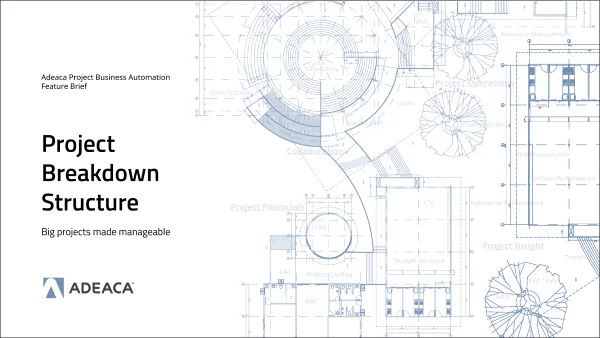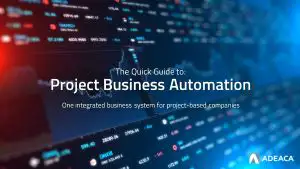Many companies delivering projects externally to their customers or managing projects internally are familiar with the work breakdown structure (WBS), a hierarchical outline of tasks required to complete a specific project. While it’s an effective way to plan the schedule for each project by breaking down the structure of a project into manageable tasks and assigning them to specific people or teams, it’s not an effective way to manage the various costs associated with that project.
Manage your WBS and CBS in the same system with Project Business Automation. Download the PBA Quick Guide to learn how.
The Problem with Managing Project Financials and Operations in a Single Hierarchy
Especially when it comes to large, complex projects that involve thousands of tasks, managing project financials based on the schedule will become almost impossible. Unfortunately, companies tend to use the WBS not only to manage the operational components of their project, but also the financial components as well.
Project solutions such as SAP EPPM do not separate the operational and financial aspects of a project. Manual cost planning in the WBS is the only way to enter the costs of a project.
Managing both the operational and financial aspects of a project in the WBS is a major project governance flaw for any company who considers projects an important part of their business. Handling both the operations and financials within the WBS results in insufficient details for operational planning and is too granular for budget, estimation, cost collection, and variance management. The single hierarchy framework jeopardizes both sides, ultimately resulting in poor project performance.
The fact is, the cost breakdown structure (CBS) is completely missing in most project tools, including project management, scheduling and the ERP. As a result, a CBS is never utilized, or it’s created and managed in multiple spreadsheets. Managing the project financials in spreadsheets means it has to be manually updated, which often leads to error and neglect simply because it’s hard to keep it up.
Employing a Cost Breakdown Structure Parallel to the Work Breakdown Structure
The only way to maximize performance and productivity, and ultimately successfully deliver projects on time and on budget, is to detach the WBS from the CBS. The solution is to employ a CBS parallel to your WBS. The CBS will allow you to manage costs and enable you to conduct real-time financial analysis directly connected to the WBS.
While the WBS is too granular for cost management, the CBS provides the right level of detail. It also allows different managers with different responsibilities on the project (operations vs cost management) to manage the project more efficiently in their own appropriate view.
Most companies today, try to create their CBS in spreadsheets. Using spreadsheets to manage the cost component of a project is not only inefficient, but completely separates it from the operational aspect so it does not represent the current reality of the project. This means the WBS and the CBS are always disconnected.
Project Business Automation: Linking the CBS to the WBS
Adeaca Project Business Automation is the only solution available that provides a CBS and WBS that work parallel with one another. The CBS in Adeaca PBA is directly and automatically updated from the WBS and vice versa. This means if a change in the schedule affects the financial aspect of a project, it’s known immediately.
As part of Adeaca’s Project Business Automation, the Project Breakdown Structure (PBS) incorporates both the WBS and the CBS together in one project super-structure. A large, complex project can be broken down into any number of embedded projects that each has its own WBS and CBS, but still automatically integrates into the Parent Project to ensure higher-level visibility and controls.
Managing complex projects involves a lot of moving parts and a lot of hands-on deck. Without an efficient system in place to make it more manageable, there’s an increase in risk and there’s no way to avoid costly mistakes. When different departments can manage their costs and operations of the project separately, while still having everything roll up into the Parent Project, big, complex projects are guaranteed to be delivered on time and on budget.
Download the Project Breakdown Structure feature brief to learn more and discover what it can do for your company.












